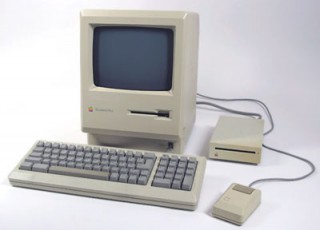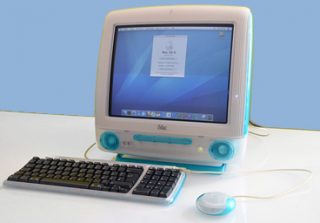2000: One of the things I used to love about my Mac Plus back in the old days is that I could put a stripped-down version of System 6 and a text editor on a floppy disk, boot the machine from that, and work in blessed silence with the (external) hard drive shut down, disturbed only by the clicking of the keys and occasional grunts from the floppy drive.
 Like the latest generation iMacs, the old Mac Plus had no cooling fan whining away.
Like the latest generation iMacs, the old Mac Plus had no cooling fan whining away.
Part of my passion for PowerBooks is that they either have no fan (older models) or one that cuts in only on demand. I trust that my 233 MHz WallStreet really does have a fan, but I’ve never heard it power up. With my old PowerBook 5300, I used to run most of the time from a RAM disk with the hard drive spun down.
I love silence – the silenter the better. The best I think I have experienced is being back in the woods on a windless winter day in a heavy but gentle snowfall. I digress.
Apparently, silence is also relished by the Austin Chronicle’s Robert Bryce, whose recent article for Salon, Hush, Little PC, is subtitled, “If Apple can make an almost silent iMac, why can’t other computer makers turn off the white noise?”
“The everyday, tangible effect of the digital revolution is that annoying white noise generated by personal computers,” says Bryce, who observes that computer engineers have done “just about everything except make the damn things quiet.”
 Bryce notes that the most silent full-size desktop computer is Apple’s fanless iMac, but he finds “its price tag too high and the available software too limiting.” He says he can’t afford to buy a new suite of software for the Mac OS or learn a new set of software commands.
Bryce notes that the most silent full-size desktop computer is Apple’s fanless iMac, but he finds “its price tag too high and the available software too limiting.” He says he can’t afford to buy a new suite of software for the Mac OS or learn a new set of software commands.
The new suite bit is a valid point, as is, I guess, the price. If you’re comparing the iMac to PC cheap-os, you tend to get what you pay for in hardware quality and refinement. Except for gamers, the “limited software” bit and the fear of learning new commands are straw men.
Bryce compares the $999 iMac to a $900 Hewlett-Packard Pavilion with a 533 MHz processor, 20 GB hard drive, a DVD player, a CD-RW, and lots of bundled software. He figures that the Pavilion offers great value, save for one thing: “it sounds like a miniature B-1 bomber on takeoff.” He should hear the Umax SuperMac S900 I just bought. Its two cooling fans also remind me of a jet aircraft, if not on takeoff, at least at cruise.
 Indeed, the IBM 2 GB hard drive in this WallStreet PowerBook I’m typing on is way too loud. It was wonderfully whisper-quiet when it was new, but it has become progressively noisier. The Fujitsu 4.6 GB drive in my son’s Lombard 333 ‘Book is quieter, but still too noisy for my taste. Oddly enough, my old PowerBook 5300, now taken over by my daughter (who has added a second, expansion bay hard drive), is quieter with two drives running than the G3 machines are with one.
Indeed, the IBM 2 GB hard drive in this WallStreet PowerBook I’m typing on is way too loud. It was wonderfully whisper-quiet when it was new, but it has become progressively noisier. The Fujitsu 4.6 GB drive in my son’s Lombard 333 ‘Book is quieter, but still too noisy for my taste. Oddly enough, my old PowerBook 5300, now taken over by my daughter (who has added a second, expansion bay hard drive), is quieter with two drives running than the G3 machines are with one.
I don’t have the Umax completely geared up yet, but I can’t imagine being able to stand working beside it all day. I really mind the noise. I was forewarned; a reader friend of mine who operates a photography business, in which he uses a bunch of Mac and Mac clone 6-slot tower machines, told me that while the SuperMac S900s are dirt-cheap and are easy to work on and easy, easy, easy to trick out, he prefers to keep his in the back room, “’cause it’s noisy.”
Robert Bryce quotes Les Blomberg, executive director of the Noise Pollution Clearinghouse, who advises stashing the computer underneath the desk, as far away from the user’s ears as possible, and notes that a 1998 report published in the British Journal of Psychology found that excessive noise can diminish office workers’ performance levels by as much as 60%. I can believe it.
On the engineering side, Apple has managed to quiet down the iMac, but there are reports that cooling is compromised in poorly ventilated installations. Compaq is phasing in hard drives that use a ceramic bearing instead of steel ball bearings, which provides a significant noise reduction advantage. The Compaq drives will also be operable in two modes, reports Bryce, “performance” or “quiet” (with drive RPMs cut by about 30%).
 A new Swedish standard specifies that computers should not emit more than 50 decibels (normal conversation is about 60 decibels). Robert Bryce himself decided to buy the Hewlett Packard machine rather than switch operating systems to get the quieter iMac, but he keeps it in a closet, with long cables running to his workstation. Must be kinda inconvenient for swapping floppies and CDs, but I may end up doing the same sort of thing with my Umax S900. If it’s this noisy when it’s brand new, what will it be like when those fan and hard drive bearings start to wear?
A new Swedish standard specifies that computers should not emit more than 50 decibels (normal conversation is about 60 decibels). Robert Bryce himself decided to buy the Hewlett Packard machine rather than switch operating systems to get the quieter iMac, but he keeps it in a closet, with long cables running to his workstation. Must be kinda inconvenient for swapping floppies and CDs, but I may end up doing the same sort of thing with my Umax S900. If it’s this noisy when it’s brand new, what will it be like when those fan and hard drive bearings start to wear?
The problem with making silent computers, of course, is that the more powerful processor chips become, the hotter they tend to run, and you have to cool them somehow. The fanless iMacs do this by convection, but my inference is that this system is only borderline efficient, and these machines may well suffer shorter service lives than units cooled by fans. Liquid cooling is another possibility. One PC manufacturer recently announced the development of a liquid cooled laptop.
And of course, even the fanless iMacs still have a hard drive grinding away – although if you have enough RAM, it would be possible to run them from a RAM Disk in sublime silence. Speaking of hard drive noise, a couple of months ago Macwelt’s Martin Stein reported (no longer online) that according to statements from IBM researchers, in the next five to ten years holographic and other kinds of storage media should take over the role of computer data storage. Holographic data storage should be blessedly silent, although that still will not address the cooling fan noise problem.
Perhaps someone will eventually come up with a microprocessor technology that does not generate vast amounts of heat, but for now, silent computing is still just a tantalizing fancy.
keywords: #quietcomputing #silentcomputing
short link: https://goo.gl/k3qT3M

